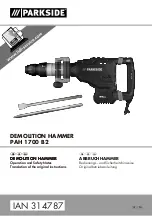
31
4.3.5 Ground and Short Circuit Test.
A simple ohmmeter check can be performed to check the unit for a short to ground, primary to secondary
breakdown, AC-DC short, or DC ground. Before installation of a new unit, the above checks should be made
before installing. If a short of this type is suspected on a unit in service, check as follows:
1.
Disconnect AC input power to the unit. Disconnect the DC battery and loads from the rectifier.
2.
Set ohmmeter scale on ohms scale RX100.
3.
Measure from one terminal of the input to one terminal of the output. Meter should not indicate. If the
meter reads full scale deflection, this indicates an ac-dc short. During shipping, an AC wire may rub against
the DC lugs, terminals, etc. And cause a short. These problems may be eliminated by being very careful in
inspecting the wiring to make certain the AC wires are not touching the DC wiring.
4.
Check the input terminals to ground and check the output terminals ground. If the meter indicates full
scale deflection, a wire is touching a metal part of the rectifier. Look for wires that are near any metal part
and inspect for possible breakdown caused by shipping. The heatsink of the diodes and the control unit are
insulated from ground through the mounting legs.
4.3.6 Troubleshooting the TRIAC
The procedure for checking the triac is as follows:
1.
On the ohmmeter, set the switches on “ohms”, “DC”, and “Rx10,000” scale.
2.
Disconnect the triac to be checked. Using an ohmmeter, measure the resistance between main terminals,
MT1 and MT2 in both directions. A good device will indicate open circuit in both directions, a low resistance
indicates a shorted device.
3.
Set ohmmeter to Rx100 scale.
4.
To check for a shorted triac gate lead, measure the resistance between gate (GATE) lead and main terminal
MT1. A reading of zero ohms in both directions indicates a shorted gate. A reading of infinity in both
directions indicates an open gate and the triac should be replaced. A good device should have resistance in
both directions, but not zero ohms.
4.3.7 Troubleshooting and Replacing Power Silicon Diodes/Modules
1.
On the ohmmeter, set the switches on “ohms”, “DC”, and “Rx100” scale.
2.
Isolate one end of the diode by disconnecting the wires attached to the nipple (or pigtail) end of the diode
(only one end of the diode must be disconnected). On a diode module, both of the outside leads must be
disconnected.
3.
Clip one lead of the ohmmeter to the anode lead of the diode. Clip the other ohmmeter lead to the cathode.
4.
Note the ohmmeter reading. Then reverse the leads to the diode. Again, note the ohmmeter reading. If
the diode is good, the meter will indicate a high resistance in one direction and a low resistance with the
leads reversed. If the diode is shorted, the meter will read full scale, or zero (“O”) resistance with the
leads in either direction. If the diode is “open”, the ohmmeter needle will not indicate or it will show infinite
resistance in either direction, indicating an open circuit.
5.
All diodes must be checked in the event that more than one diode is defective.
6.
If the diode is defective, remove the defective diode from the heatsink and replace with a new diode.
4.3.8 Checking
Capacitors
1.
When checking capacitors be sure all AC power is turned off and battery is disconnected from unit. Check
capacitors with DC voltmeter to see that DC voltage is at near -0- volts.
2.
Momentarily short circuit the capacitor leads to assure complete discharge.
3.
Connect the meter test leads to the capacitor leads or terminals and observe indicated resistance.
4.
A good capacitor will indicate an initial low resistance and gradually increase as the capacitor charges. The
final resistance of a good capacitor is usually several hundred thousand ohms approaching a megohm.
5.
Initial high resistance approaching infinity indicates an open capacitor. Initial and continued low resistance
readings indicate a shorted capacitor.
When ordering replacement parts, drawings, or schematics, always give model number, serial
number and AC input voltage.









































